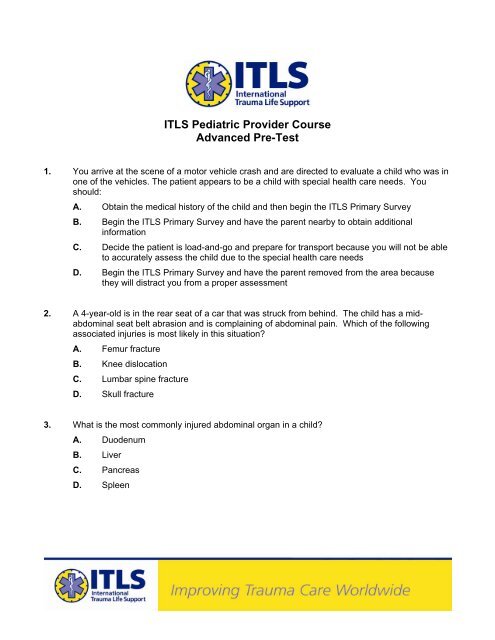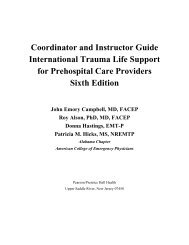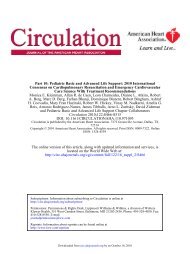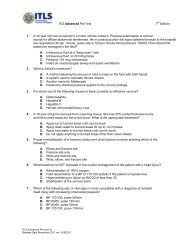PITLS Advanced Pre-Test
PITLS Advanced Pre-Test
PITLS Advanced Pre-Test
You also want an ePaper? Increase the reach of your titles
YUMPU automatically turns print PDFs into web optimized ePapers that Google loves.
ITLS Pediatric Provider Course<br />
<strong>Advanced</strong> <strong>Pre</strong>-<strong>Test</strong><br />
1. You arrive at the scene of a motor vehicle crash and are directed to evaluate a child who was in<br />
one of the vehicles. The patient appears to be a child with special health care needs. You<br />
should:<br />
A. Obtain the medical history of the child and then begin the ITLS Primary Survey<br />
B. Begin the ITLS Primary Survey and have the parent nearby to obtain additional<br />
information<br />
C. Decide the patient is load-and-go and prepare for transport because you will not be able<br />
to accurately assess the child due to the special health care needs<br />
D. Begin the ITLS Primary Survey and have the parent removed from the area because<br />
they will distract you from a proper assessment<br />
2. A 4-year-old is in the rear seat of a car that was struck from behind. The child has a midabdominal<br />
seat belt abrasion and is complaining of abdominal pain. Which of the following<br />
associated injuries is most likely in this situation<br />
A. Femur fracture<br />
B. Knee dislocation<br />
C. Lumbar spine fracture<br />
D. Skull fracture<br />
3. What is the most commonly injured abdominal organ in a child<br />
A. Duodenum<br />
B. Liver<br />
C. Pancreas<br />
D. Spleen
4. Which of the following is most consistent with EARLY hypovolemic shock in a 1-year-old<br />
A. Pulse, 120 bpm; BP, 80/60<br />
B. Pulse, 120 bpm; BP, 60/30<br />
C. Pulse, 160 bpm; BP, 80/60<br />
D. Pulse, 160 bpm; BP, 60/30<br />
5. Which of the following findings are most consistent with increased intracranial pressure in a<br />
child<br />
A. High BP; fast pulse<br />
B. High BP; slow pulse<br />
C. Low BP; fast pulse<br />
D. Low BP; slow pulse<br />
6. Which of the following is considered normal for newborn to 3-month-old infant<br />
A. Respiratory rate of 40 bpm<br />
B. Pulse of 80 bpm<br />
C. Sunken fontanel<br />
D. Respiratory retractions<br />
7. Injury to what area of the body is the leading cause of traumatic death<br />
A. Extremities<br />
B. Head<br />
C. Chest<br />
D. Abdomen<br />
8. Which of the following statements is most important in the field management of the hypothermic<br />
submersion<br />
A. Keep the patient in the water until you are ready to transport<br />
B. Apply warm, moist towels to the body surface<br />
C. Initiate warmed humidified oxygen<br />
D. Remove wet clothing and dry the patient
9. Which of the following causes the greatest amount of stress to a 2-year-old child<br />
A. Separation from parents<br />
B. Oxygen mask on the face<br />
C. Scolding by a relative<br />
D. Lost blanket<br />
10. Which of the following is the LAST sign of compartment syndrome to develop<br />
A. Absent pulse<br />
B. Decreased sensation<br />
C. Severe pain<br />
D. Swelling<br />
11. Which of the following is the most common cause of traumatic cardiopulmonary arrest in a<br />
child<br />
A. Cardiac tamponade<br />
B. Respiratory compromise<br />
C. Cervical spine fracture<br />
D. Tension pneumothorax<br />
12. Which of the following is TRUE regarding flail chest in a child<br />
A. Diagnosed by tracheal deviation<br />
B. Often associated with severe lung injury<br />
C. Treated with needle decompression<br />
D. Usually not very serious<br />
13. You are called to the home of a 9-month-old child who has second-degree burns from the waist<br />
down. The mother says the child crawled into the tub, turned on the hot water, and then sat in<br />
the water. The boyfriend says the child’s 2-year-old sister turned on the water. What is the<br />
most appropriate course of action<br />
A. Call the police to the house<br />
B. Explain to the family that you suspect abuse and ask for a better history of what<br />
happened<br />
C. Notify the local children’s services department and ask them to come to the house<br />
D. Transport the child to the hospital and then report your concerns to the appropriate<br />
agencies
14. A 10-year-old is first evaluated three hours after suffering third-degree burns to 50 percent of his<br />
body. His unburned skin feels cool and clammy, pulse is rapid, and breath sounds are clear and<br />
equal. Which of the following best explains these findings<br />
A. Hemorrhage<br />
B. Hypovolemia<br />
C. Hypoxia<br />
D. Sepsis<br />
15. Pediatric patients with suspected extremity fractures should:<br />
A. Be assessed in the same manner as an adult<br />
B. Be assessed utilizing the specialized pediatric fracture criteria (PFC)<br />
C. Not be treated for pain because they have a high pain tolerance<br />
D. Not have the joint above or below a fracture site immobilized because this may cause<br />
damage to the growth plates<br />
16. You have completed the Scene Size-Up and Initial Assessment of a pediatric patient who was<br />
involved in a roll-over MVC. Your next step is to:<br />
A. Perform a Focused Exam<br />
B. Perform a Rapid Trauma Survey<br />
C. Perform an ITLS Ongoing Exam<br />
D. Load-and-go<br />
17. Which one of the following is TRUE regarding pediatric vital signs<br />
A. Normal vital signs vary among pediatric age groups<br />
B. Normal systolic BP is the child's age, in years, multiplied by 2 and added to 70<br />
C. Normal pulse rate is the child's age, in years, multiplied by 4 and subtracted from 150<br />
D. Normal respiratory rate is the child's age, in years, multiplied by 4 and subtracted from<br />
40<br />
18. The best way to recognize EARLY shock in children is:<br />
A. Tachycardia and poor perfusion<br />
B. Oxygen saturation of below 96% and tachycardia<br />
C. Rapid breathing and bradycardia<br />
D. Slow breathing and bradycardia
19. Which of the following statements is TRUE about spinal motion restriction for children<br />
A. It is well tolerated by children because they think it is a game<br />
B. Adult equipment may be used as long as the principles of securing and neutral position<br />
are maintained<br />
C. Pediatric-specific spinal motion restriction devices are required<br />
D. It should not be performed on the conscious pediatric patient<br />
20. Injury to which abdominal organ most commonly causes death in the child<br />
A. Kidney<br />
B. Liver<br />
C. Pancreas<br />
D. Spleen<br />
21. What is the narrowest portion of an infant’s airway<br />
A. Epiglottis<br />
B. Oropharynx<br />
C. Subglottic area<br />
D. Vocal cords<br />
22. Compared to an adult airway, which of the following is TRUE of the child’s airway<br />
A. The epiglottis is angled away from the trachea<br />
B. The larynx is lower down in the neck<br />
C. The subglottic area is the widest portion of the larynx<br />
D. The tongue is relatively smaller<br />
23. Needle decompression of the chest in children is indicated for:<br />
A. Open pneumothorax<br />
B. Massive hemothorax<br />
C. Unrelieved airway obstruction above the cricothyroid membrane<br />
D. Diminished breath sounds, hypotension, distended neck veins and tracheal deviation
24. Which of the following regarding pediatric intubation is TRUE<br />
A. The glottic opening is the narrowest part of the pediatric airway<br />
B. Nasotracheal intubation is the method of choice in the traumatized child<br />
C. The Sellick maneuver should not be used on a child<br />
D. Suctioning an infant may cause bradycardia<br />
25. A 3-year-old weighing 10 kg. is injured in a motor vehicle collision. His skin is cool and pale.<br />
Vital signs are: respiratory rate, 40 bpm; pulse rate, 140 bpm; and BP, 70/40. Which of the<br />
following initial intravenous fluid therapies is most appropriate<br />
A. D5W at keep-open rate<br />
B. Normal Saline at keep-open rate<br />
C. Normal Saline 100 mL bolus<br />
D. Normal Saline 200 mL bolus







